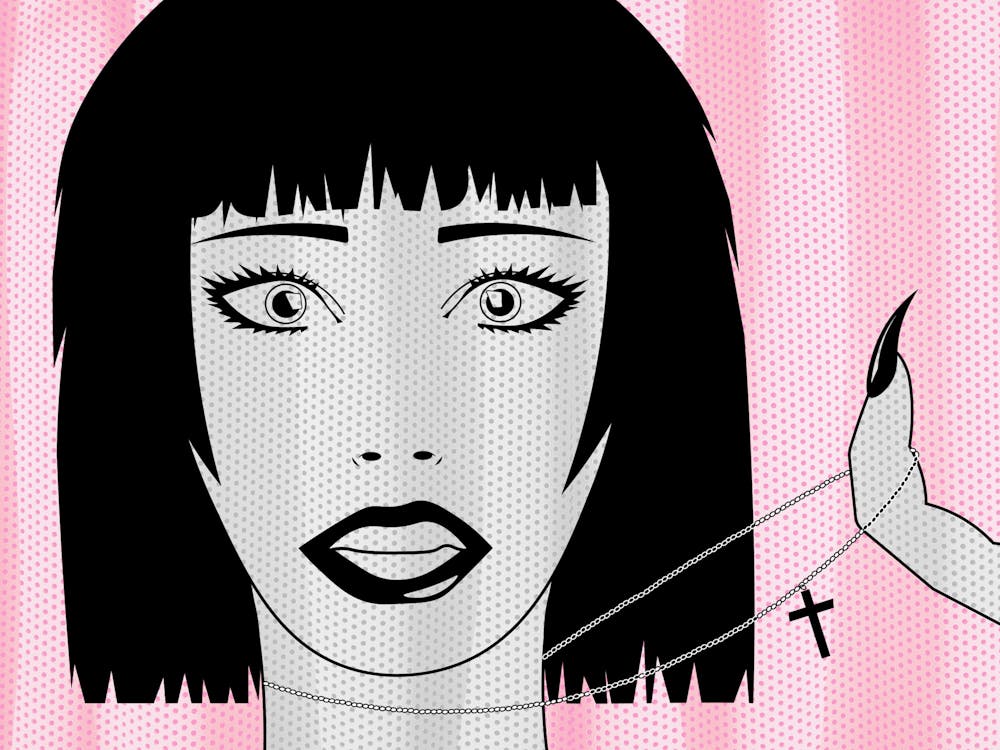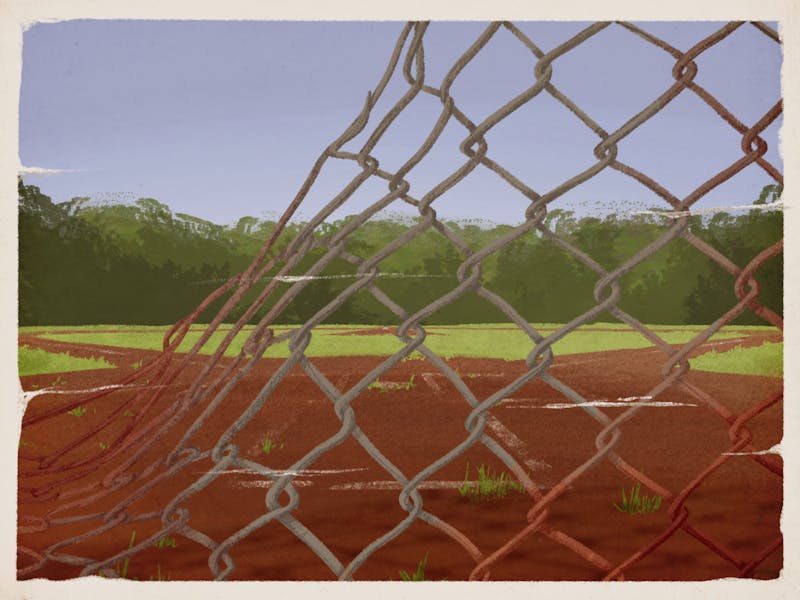Maggie’s grandmother used to quilt. Patch after patch, she would stitch together colorful squares and harsh floral and paisley patterns until they formed silhouettes of Jesus and Mary or a massive cross. She mainly made these Christian-patterned quilts for family and people at her church. Every birthday party, Christmas dinner or Easter service was marked by Maggie’s grandmother bringing an armful of quilts for people to take home. It was always a big hit.
Every new baby born into the family got a quilt. Maggie still had hers. The once-white cross was stained with Kool-Aid and baby food. The poppy fabric around the cross, previously fire-engine red, had rusted over. Yellowing strings now frayed around the edges of each square like little thin worms crawling out from under the dirt.
This quilt tried to keep her safe as a kid. Maggie would hide under it to fall asleep, hoping it would ward off the demons and monsters that her preacher said came to her during the night, creeping out of her closet, and found residence in her body, in her heart. The preacher said those demons and monsters were sent by the Devil, and during the day, sometimes those entities would take over her body. That's why Maggie stole candy from the candy jar or wanted to dye her long blonde hair purple. That’s why she had a crush on another girl in the church choir. The preacher told Maggie that she had to fight these demons and the thoughts they gave her. She had to keep them out, and she hoped the quilt would do that.
Of course, it didn’t. Maggie still sinned here and there. She still had a crush on the girl in the choir. After a while, she stopped thinking the quilt would protect her. A little while longer and she began to believe it was only hurting her. At night, Maggie had dreams of the quilt opening up, the seams splitting apart and forming a giant opening like a big black mouth with sharp stringy teeth. It would swallow her whole and she would be left in its stomach. Maggie would claw at the walls, blood covering her arms up to her shoulders as she reached in, hearing the snaps and cracks as she pulled out shards of bone and smooth pink mush. She would sling rib bones, intestines, lungs and spleens behind her until her hand felt something moving, a heart beating hot and wet.
The dreams became daydreams, then constant films in the back of her mind. Day after day Maggie would drift off, dreaming up whatever twisted and horrific story she could think of: the candy jar biting her hand off as she reached in, her hair falling out clump after clump, that choir girl stabbing her in the gut with a sharp silver knife. With thoughts like these, it was no surprise that she fell in love with horror. And despite her family’s attempt to shelter her from all things they deemed evil, she saw the first character she had ever related to on TV: Carrie. Deeply religious, outcasted and queer-coded, when Carrie broke free of her confines, Maggie longed to as well. She watched as Dracula, Frankenstein’s monster, and packs of werewolves came out as their true, monstrous selves. She wondered if their quilts failed them too.
In every movie Maggie watched, she related to the villain. She wore a mask just like they did. She still went to church and slept with her grandmother’s quilt at night, anxiously toying with the fly-away strings. She never got in trouble, and when asked about boys, she suddenly had a devout yearning for Zac Efron. Like the villains, she knew people were scared of her, or at least, people like her. She noticed how people would turn their kids away when they saw two men holding hands on the street. People like her were the Invisible Man. They could be anywhere and you wouldn’t even notice. They have infiltrated the masses—keep your children safe. And to her church, to her family, she was a villain in her own right. To them, she was either possessed by the Devil or, worse, choosing this life, one that would lead her to a dark cell in hell.
But the more she watched, the more empowered she became. She realized how much power she held over others. Just like the horror movie villains, people feared her very existence. People like her just lived their lives and others were so afraid of them, so afraid of what they stood for and their challenge to the status quo. People out there lived in fear that people like her would become their bosses, alter the nuclear family mirage they worked so hard to maintain and, worst of all, rip their quilts into piles of shredded cloth and torn string. This gave Maggie a sense of power she had never felt before, power that gave her the courage to retire her quilt. She put it in her closet, right next to the monsters. They could have it.
By no means were horror movies perfect. In fact, some may say they were perpetuating the images of queer people that kept her locked tightly away in the closet. But they made her feel seen. They helped her feel a little less alone. She often thought back to her dream and the guts and viscera she dug through night after night, worried she would find nothing in the carnage and yet finding that bright and beating heart. Horror showed her that underneath all the blood and filth, there is meaning, there is someone’s story, there is her story.
—
Every new baby born into the family got a quilt. Maggie still had hers. She brought it with her to college, then to her first apartment, then to her girlfriend’s house when she moved in.
Thrown into closet after closet, the quilt was tattered and filthy. It had been mostly forgotten until she found it one day when digging through the closet, looking for clothes to donate. There it was, sitting in the bottom of a drawer, the cross now littered with moth holes and stuffing oozing out like bleeding flesh wounds.
Maggie was shocked at first. Why did she even still have this thing? She thought she remembered the quilt being larger, brighter, fuller. She would never forget the internalized homophobia the quilt made her feel. The guilt and self-hatred seemed once to be sewn in its very seams. But now, with the holes and the tears, the quilt looked so small, so pitiful. Those feelings, once so overwhelming, seemed so far away now.
She could’ve thrown the quilt away. She could have set it on fire or thrown it into the Atlantic. She remembered how she once wanted to, but now, it would feel like beating a dead horse. The thing was pathetic. So, she pulled the quilt out of its drawer and she grabbed her needle and thread. She had bought some horror movie patches a few weeks back to sew onto her leather jacket. She grabbed those too. And she sat on the floor of her closet for the rest of the day, sewing pieces of black cloth with iconic horror movie characters on them across the moth holes. The faces of Jason Voorhees, Freddy Krueger, Dracula, Pennywise, Chucky and Michael Meyers spotted about the cross and amongst the poppies.
Good as new.



